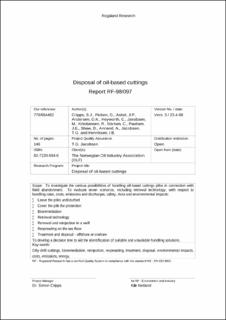Disposal of oil-based cuttings
| dc.contributor.author | Cripps, S.J. | |
| dc.contributor.author | Picken, G. | |
| dc.contributor.author | Aabel, J.P. | |
| dc.contributor.author | Andersen, O.K. | |
| dc.contributor.author | Heyworth, C. | |
| dc.contributor.author | Jakobsen, M. | |
| dc.contributor.author | Kristiansen, R. | |
| dc.contributor.author | Marken, C. | |
| dc.contributor.author | Paulsen, J.E. | |
| dc.contributor.author | Shaw, D. | |
| dc.contributor.author | Annand, A. | |
| dc.contributor.author | Jacobsen, T.G. | |
| dc.contributor.author | Henriksen, I.B. | |
| dc.date.accessioned | 2020-12-08T13:46:35Z | |
| dc.date.available | 2020-12-08T13:46:35Z | |
| dc.date.issued | 1998 | |
| dc.identifier.isbn | 82-7220-894-6 | |
| dc.identifier.uri | https://hdl.handle.net/11250/2712444 | |
| dc.description.abstract | Scope: To investigate the various possibilities of handling oil-based cuttings piles in connection with field abandonment. To evaluate seven scenarios, including retrieval technology, with respect to handling rates, costs, emissions and discharges, safety, risks and environmental impacts: · Leave the piles undisturbed · Cover the pile for protection · Bioremediation · Retrieval technology · Removal and reinjection in a well · Respreading on the sea floor · Treatment and disposal - offshore or onshore To develop a decision tree to aid the identification of suitable and unsuitable handling solutions. | en_US |
| dc.description.sponsorship | The Norwegian Oil Industry Association (OLF) | en_US |
| dc.language.iso | eng | en_US |
| dc.publisher | Rogalandsforskning | en_US |
| dc.title | Disposal of oil-based cuttings | en_US |
| dc.type | Research report | en_US |
| dc.source.pagenumber | 150 | en_US |
